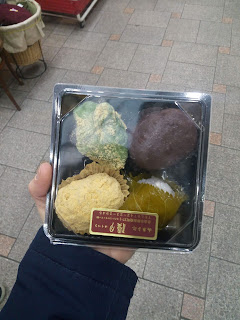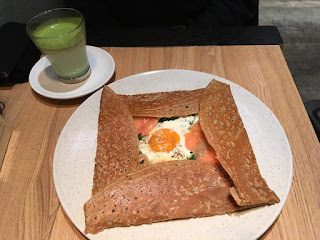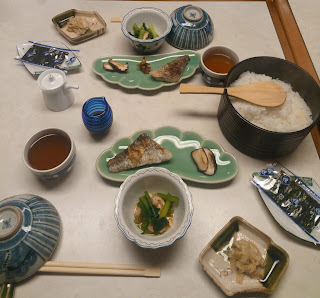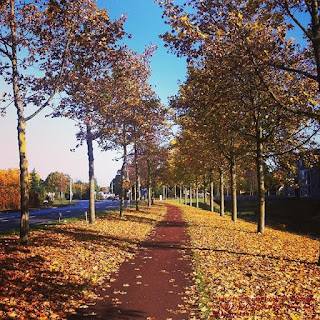⟴ My gluten-free adventure in Japan
I have recently come back from 18 days trip in Japan and wanted to share my gluten-free experience, in order to help coeliac friends worldwide who might want to travel there, but are worried about what to eat in this amazing country. Having coeliac disease seince I was 6, I am quite used to eating gluten free and I am confortable with the idea that I can easily find places to eat where I live. That is why, after the initial excitement following the booking of the flight tickets to Japan, I sudddenly panicked wondering what I could eat in a country in which gluten was very little known (or not known at all in some cases!), facing the difficulties of the language barrier. Some of you might think "oh come on, Japanese cuisine is rice and fish-based, which you can perfectlily eat", which is true but also means that:
- Coealiac disease is very uncommon in Japan, which makes difficult to explain what is your problem to locals;
- Japanese people don't know about the risk of cross-contamination;
- Japanese cuisine is not as simple as it looks like: most dishes are prepared with soy sauce, which contains wheat. This means that you have to check carefully the products you are going to eat and see whether it contains (or has been prepared with) soy sauce.
Preparation before departure is key, and this is my first and biggest advice. Way before the departure I did a lot of research on the Internet, reading articles from blogs of other coealiacs or gluten-intollerants, including restaurant reviews, posts on facebook groups etc.
Preparation also affects your luggage. Since you will not find labelled gluten free products in supermarkets in Japan, I definitely recommend to bring your "basics" in your bag: bread, biscuits/snacks and crackers are essentials. I easily managed to fill my hand luggage with part of my clothes and my food basics, and did not regret it at all. You will likely eat your food supply throughout the journey and will have an empty luggage for gifts and souvenirs!
Preparation also affects your luggage. Since you will not find labelled gluten free products in supermarkets in Japan, I definitely recommend to bring your "basics" in your bag: bread, biscuits/snacks and crackers are essentials. I easily managed to fill my hand luggage with part of my clothes and my food basics, and did not regret it at all. You will likely eat your food supply throughout the journey and will have an empty luggage for gifts and souvenirs!
The second advice is getting a translation card with a simple explaination (in Japanese, of course) of what coeliac disease is and that you need to avoid gluten from your diet: this has been my shadow (and life-saver), so every time I had to get something to eat I showed the paper to the staff and managed to arrange with them a simple meal. I have used the card provided by celiactravel.com (http://www.celiactravel.com/cards/japanese/ ) in combination with another one which listed the ingredients containing gluten and the ones which were safe for me (you can use google translate for making this one). A good suggestion with these cards is to keep them very simple (even if our intollerance is far from being simple, as we know), explaining that you have an allergy to wheat, barley, rye, oats and to soy sauce and you will see that people will try their best to accomodate your needs (allergies are taken very seriously there). If they cannot, they will tell you, as it happened to me once at a restaurant: after consulting with the chef, the waiter was so nice to explain me that he could not guaarantee the complete absence of gluten due to cross contamination in the chicken, which I really appreciated, regardless.
Another useful tool for me was google translate: I downloaded the offline Japanese dictionary and through the app in my mobile phone I could scan and translate instantly the ingredients listed on a product. Sometimes it is not easy and you will not get a perfect translation, but at least you will easily identify the kangi for wheat, soy sauce and so on. A good tip here is memorising the world for gluten, wheat, rye, oats, barley, soy sauce or having them noted down so that you can already look for them on the ingredient list. This was my daily (and super funny) job when visiting "Combini" (convenience stores) where I was able to find good options such as salads (be careful with the dressing!), ice cream, rice, eggs, edamame and Mochi which are traditional sweets made with rice-flour and filled with Azuki (red beans) paste. These are delicious and some are gluten free (always check the label for the khangi).
Mochi purchased from a local store in Nara city center (after consulting with the owners and showing them the translation card)
Other traditional japanese food you can eat is yakitori (chicken skewers) which you can easily find both in local markets and resaturants: make sure that they are not flavoured with soy sauce (the ones available in combini stores are!), but just with salt ("shio" in Japanese).
Another good street food option are baked sweet potatoes (always check for soysauce) and fish products at local markets (I had octopus skewer with black pepper) after making sure they don't add soysauce.
I also found onigiri (rice balls with fish or meat filling), but I would recommend only the plain one (without filling), always having the label checked. Here comes another tip: bring your own gluten free soy sauce (or Tamari sauce), so you can enjoy sushi and enrich plain rice balls with its flavour. I had bought it before departure and put it in small bottles of 100 ml so I could bring them in my backpack.
Having these tips in mind, you will be surprised to find out that eating gluten free in Japan is not impossible after all: you only need a lot of patience but, once there you will enjoy the wonders of this country without even thinking about your diet. Moreover, you will be twice as happy to know that there are places where you can actually enjoy gluten free Japanese dishes. Here are the ones I have tried:
奈良市 Nara:
広島市 Hiroshima:
京都市 Kyoto:
Mochi purchased from a local store in Nara city center (after consulting with the owners and showing them the translation card)
Other traditional japanese food you can eat is yakitori (chicken skewers) which you can easily find both in local markets and resaturants: make sure that they are not flavoured with soy sauce (the ones available in combini stores are!), but just with salt ("shio" in Japanese).
Yakitori at a restaurant in Nara (the soy sauce is the GF one I brought)
Another good street food option are baked sweet potatoes (always check for soysauce) and fish products at local markets (I had octopus skewer with black pepper) after making sure they don't add soysauce.
Octopus skewer with black pepper at a local fish market in Tokyo
Grilled oyster with lemon in Miyajima
Having these tips in mind, you will be surprised to find out that eating gluten free in Japan is not impossible after all: you only need a lot of patience but, once there you will enjoy the wonders of this country without even thinking about your diet. Moreover, you will be twice as happy to know that there are places where you can actually enjoy gluten free Japanese dishes. Here are the ones I have tried:
奈良市 Nara:
- Gluten Free is The New Black (11-43, City Homes 奈良 114 Shibatsujicho, Nara, 630-8114): this little café, not far from Nara Central Station, is owned by a woman who is gluten intolerant, hence everything in there is handly made by her - gluten free. It offers nice options for breakfast, brunches and delicious sweets (muffins, cakes, brownies etc.). I had breakfast with my friend there and tried a slice of poppy seeds cake, a brownie and a matcha muffin; they were absolutely delicious. The cappuccino was very good as well. The cafe has a webiste: https://www.glutenfreeisthenewblack.info/ and is also on Instagram: https://www.instagram.com/gluten_free_is_the_new_black/
広島市 Hiroshima:
- CoCo Ichibanya (2 Chome-7-2 Otemachi, Naka Ward, Hiroshima, 730-0051): if you want to try Japanese curry, this is a good option, as it offers gluten-free curry with rice. The dish will be served with a prepackaged curry which will be heated before, so don't be scared, it's just to avoid cross contamination.
京都市 Kyoto:
- Teuchi Toru Soba (〒604-0831 Kyoto, Nakagyo Ward, 二条通東洞院東入松屋町35-1): if you want to try traditional Soba noodles this is the place for you, not far from the Nijo Castle. Soba are made with buckwheat so normlly they should be safe for us. However, in most of the soba preparation there is wheat flour added; that is the reason why they are risky. In this place the owner (super kind), after I showed him the translated card, told me that he knew the problem and assured me that he makes the noodles with 100% buckwheat flour, so the normal cold soba (without the soup, he will tell you which ones) are gluten free. Imagine the joy I felt when trying for the first time soba; they were absolutely delicious! Plus you will be enchanted by the way the owner makes the dishes. I came back twice to this place and would have come everyday if it was not for my travel schedule :)
- Breizh Café Crêperie Kyoto (14-1 Ishibashicho, Nakagyo Ward, Kyoto, 604-8036): this (French) place located in Kyoto's city center makes crèpes with buckwheat flour. Always inform the staff that you need to eat gluten free (they speak English), as not all the menù is ok for us. I had a salty crèpe with salmon, eggs and greens; it was super good.
Ps: the green drink is Matcha, a traditional Japanese tea, you will find it everywhere and it is gluten free.
金沢市 Kanazawa:
- Murataya (1 Chome-5-2 Katamachi, Kanazawa, Ishikawa 920-0981): this not a restaurant but a Japanese guest house (known as Ryokan). My friend and I stayed there when visiting Kanazawa. Since the breakfast was included in the price (most of ryokans works like this), I had informed the owner about my diet and he assured me he would have prepared something for me. It was worth it, as once there I was able to enjoy a gluten free traditional Japanese breakfast which was absolutely good. Plus, the owner is well informed about food allergies and will show you a map of places to eat in Kanazawa according to your dietary needs. If you are willing to stay in this place, make sure to inform the owner as soon as you book the room, and with due time before your arrival so the he can arrange better.
Traditional Japanese breakfast during my staying at Murataya: rice, fish, vegetables and omelette (they also have gluten free soy sauce).
鎌倉 Kamakura:
- Gokuraku Curry (3-9-47 Yuigahama, Kamakura, Kanagawa 248-0014, ): I have spotted this place during my day trip to Kamamkura. I have not tried it though, but worh mentioning (also 10 points for the funny sentence "celiac customer welcome"):
東京Tokyo:
- Littlebird cafè (〒151-0064 Tokyo, Shibuya City, Uehara, 1 Chome−1−20 JPビル): last but not least, this is a little café located in the Yoyogi Park/Shibuya area and it is a Coeliac PARADISE. Literally, every coealic/gluten intollerant visiting Tokyo should try this place. Here you can eat safely 100% gluten free traditional Japanese food without worrying about cross-contamination, as it makes gluten free only. The first time I went I decided to try Okonomiyaki, then I came back and tried ramen plus a dessert. Everything was super delicious (I would have skipped the waffle, since it is not traditional, but they are huge ad can be a good option for breakfast). The lady working there was also super nice and friendly; the prices affordable as well.
Little bird cafe: I had okonomiyaki, ramen and waffle with ice cream
To conclude, there is a facebook group where you can find useful tips, advice and reviews from other people living their gluten free experience in Japan: https://www.facebook.com/groups/glutenfreeexpatsjapan/
Overall, finding gluten free options during our staying was not impossible as I feared. Obviously, you have to prepare yourself in advance and bring a lot of patience, as giving up food in a country like Japan is very hard. Nevertheless, there are still so many other things to enjoy while travelling and I am sure you will be so amazed by the stunning beauty of this country that soon you will forget about the rest. Personally, I do not regret a single day spent in Japan. I am proud of what I experienced and learned from this country: the magic of its temples, the beauty of its nature, the peace of its gardens, the kindness of its people, the crowd in the big cities, the mystery behind its traditions and the contrast with modernity, the smell of incense, the scent of cherry trees. These are all things worth going to, so do not be afraid, do not make your gluten free diet a burden, but step out of your comfort zone, embrace uncertainty, and enjoy the journey.
Cherry tree in Tokyo
A special thanks to Antonio and Alice for having encouraged me to leave. You did wonders.




























Comments
Post a Comment